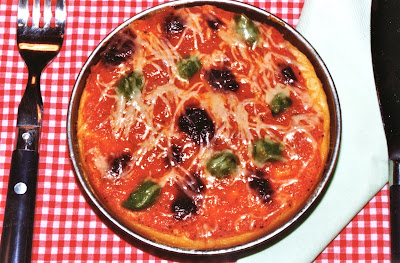Preparation of a soft diet pizza base can be
challenging. In my publication Super Foods for Small Appetites I created
a soft polenta base with purée or soft texture toppings. See illustration.
This works extremely well but can be very filling to eat; and leftovers are not always desirable when the appetite is poor.
 |
| Example of Textures B and C – Minced and Moist and Smooth Puréed Diet - Pizza |
The very recent trend to chop cauliflower finely,
to steam and substitute it for rice (to cut kilojoules from the diet) has led to
a recipe in ‘Australian Healthy Food Guide’ (Sept. 2015, page 22) for a
Cauliflower Pizza Crust. I tried this with my family, with an overwhelmingly
positive result. It occurred to me that it was perfect to adapt it for a soft
diet and even a minced and moist diet if the toppings were suitable.
I chose toppings to meet the requirements of a
soft diet. The very small orange tomatoes on the topping were roasted with a
small sprinkle of salt, and a spray of olive oil until the skin became very
soft. This may not be acceptable in some cases and you could easily substitute with
skinned roasted capsicum or skinned tomato.
Cauliflower Crust Pizza with Soft Topping
Ingredients Serves 4
1 cauliflower head (approx. 1 kg trimmed)
2 eggs lightly beaten
1 tsp dried oregano or 2 tsp fresh finely chopped.
90g Parmesan cheese finely grated
20g tomato paste
200g very small tomatoes roasted
1 avocado peeled and stone removed (approx. 200g).
Method
1.
Cut cauliflower into small pieces and finely
chop in a food processor.
2.
Transfer to a microwave proof bowl, cover and
cook for 8 mins. Leave to cool and drain well squeezing some of the water from
the soft mass.
3.
Preheat oven to 200C or 180C if fan forced and
line two pizza trays with baking paper in preparation for the prepared crust.
4.
Mix the cauliflower with the eggs, oregano and one
third of the Parmesan cheese until a thick cohesive mass is formed.
6.
Spread with tomato paste, sprinkle with the
roasted tomatoes and sliced avocado. Spread the rest of the parmesan on top,
7.
Bake for a short time until cheese has melted.
 |
| Example of Texture A: Cauliflower Crust Pizza with soft topping |
Nutrition Information per serve: Energy 1384kJ, protein 19g,
fat 23.9g, sat fat 7.9g, carbohydrate 7.2g, fibre 6.3g, sodium 436mg.
Alternative toppings for a soft diet include:
- Cooked pumpkin, feta cheese and baby spinach.
- Ham, skinned capsicum and onion cooked until soft plus cheese (parmesan works best, without going tough in the oven).
- Tomato and onion preferably skinned with zucchini cooked until soft with cheese
- Sardines, goats cheese and soft cooked figs or quince.
- Toppings for a minced and moist diet could be cooked and chopped until pieces less than 0.5cm, but would need to be served with a thick sauce. It may be safer to purée any toppings to go onto the cauliflower crust that in itself has a soft cohesive texture easy to break up in the mouth with the tongue.
HAPPY PIZZA MAKING









